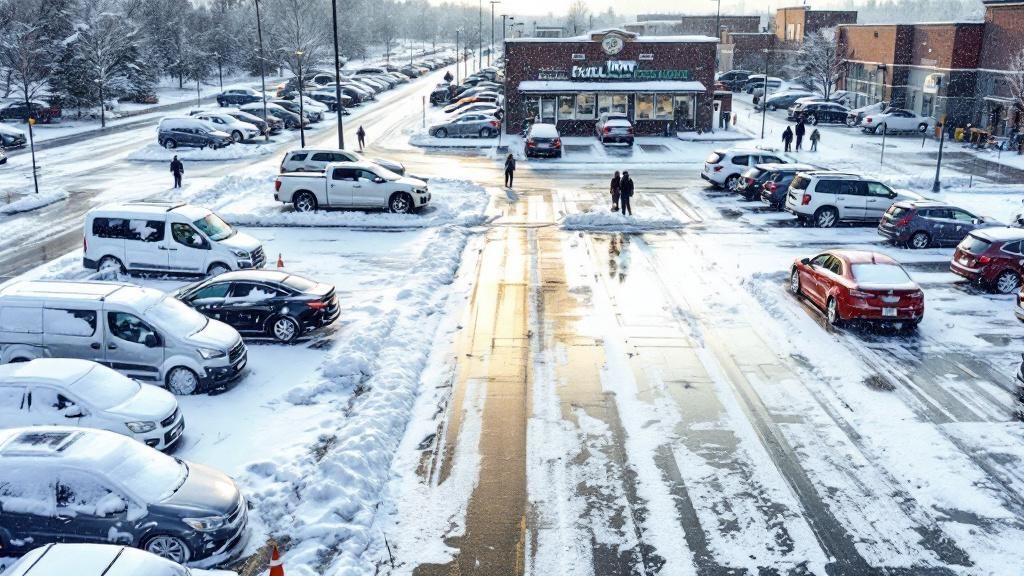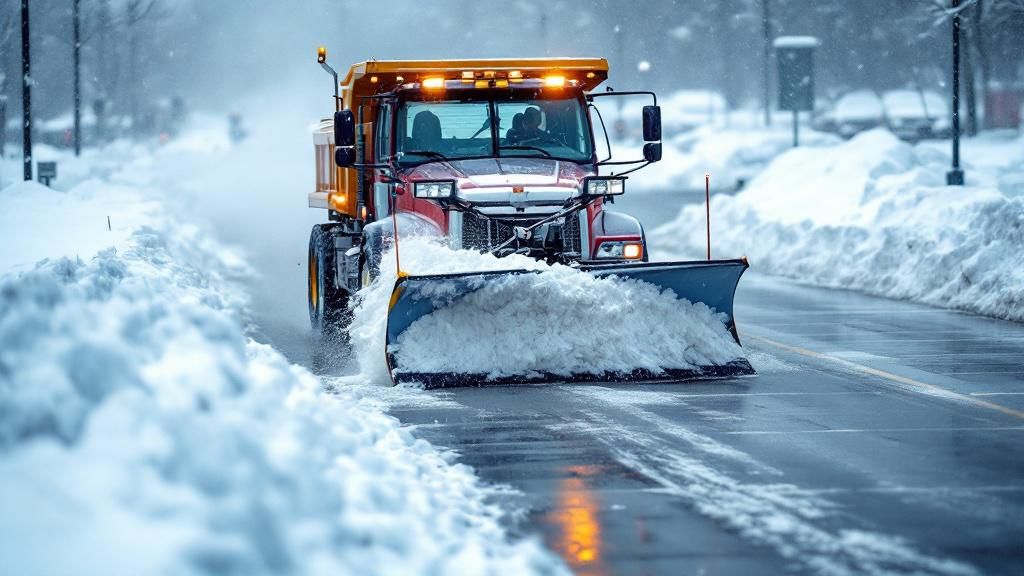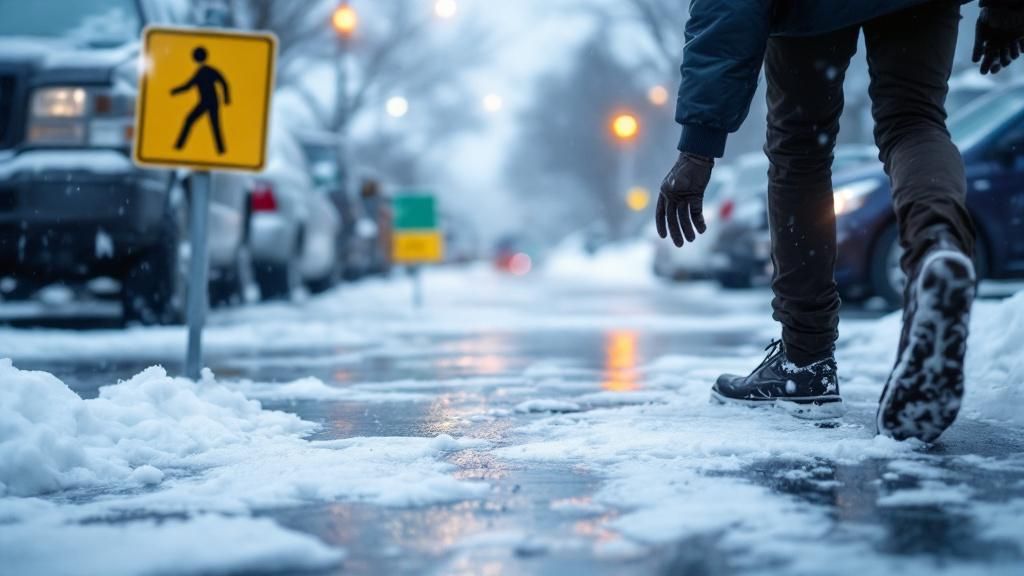
Parking Lot Snow and Ice Management in Anchorage
Key Takeaways
-
Snow and ice in parking lots pose serious safety and liability risks for businesses.
-
Ice buildup can damage vehicles, hinder access, and lead to slip-and-fall incidents.
-
Proactive snow and ice removal ensures compliance with local codes and protects your property.
-
De-icing strategies like pre-salting and improved drainage help minimize hazards.
-
Anchorage businesses must prioritize snow management to avoid disruptions and legal exposure.
In Anchorage, managing snow and ice in parking lots is more than a winter inconvenience—it’s a safety and legal responsibility. Accumulated snow can obstruct visibility, block access to parking spaces, and create hazardous conditions for both drivers and pedestrians.
Anchorage Municipal Code has clear regulations on snow placement and rights-of-way, and violations may result in fines or forced removal. More importantly, snow left unchecked increases the risk of accidents—especially for children, older adults, and individuals with limited mobility.
For business owners, poor snow management not only endangers people but also affects operations. Customers are less likely to visit a location where walking or parking is unsafe, and staff injuries from icy conditions can result in work absences and liability claims.
Challenges in Commercial Snow Management
Snow removal in commercial parking lots comes with unique challenges that differ from residential snow clearing. These include:
Obstructed Signage and Markings
Snow can cover essential parking lot signs and directional markings, creating confusion and increasing the likelihood of fender benders or pedestrian incidents. Strategic snow management ensures signs remain visible and traffic flows smoothly.
Snow Pile Placement
Dumping snow in the wrong location can block access or interfere with drainage. Best practices include:
-
Plowing with the storm to prevent buildup
-
Keeping snow away from storm drains
-
Avoiding snow piles at entrances and exits
Navigating Tight Spaces
Curbs, parked cars, islands, and odd angles make it difficult for snowplows to operate effectively. This calls for experienced operators who can maneuver safely while clearing snow thoroughly.
Legal and Financial Implications of Ice Hazards
Slip-and-fall injuries are among the most common and costly claims against commercial properties in winter. According to CDC data, winter slips and falls cost Americans an estimated $50 billion in medical expenses in 2015 alone.
Property owners are expected to maintain safe conditions under the Occupiers Liability Act, meaning they must actively manage snow and ice. Failing to do so can result in lawsuits, insurance claims, and damaged reputations.
Proper drainage and consistent monitoring are key. Ice often forms in low spots and shaded areas, especially after temperature fluctuations. Installing trench drains and sloping the pavement properly helps prevent pooling and ice formation.
Smart De-Icing and Ice Control Techniques
Preventing ice before it forms is far more effective than reacting after conditions worsen. Here are effective ice control strategies for Anchorage:
Pre-Salting
Applying salt before snowfall prevents bonding between snow and pavement, making removal easier. It also reduces the amount of salt needed later.
Treated Salt
Using calcium or magnesium chloride-treated rock salt extends melting capabilities down to -7°C (20°F), ideal for Anchorage’s extreme cold.
Anti-Icing Liquids
Spraying de-icing liquid before a storm can help prevent buildup and reduce labor during cleanup.
Sanding
Sand provides immediate traction but doesn’t melt ice. It’s best used in combination with salt or when temperatures drop too low for salt to be effective.
Reducing Liability with Consistent Snow Monitoring
Monitoring weather forecasts and maintaining a snow log can help commercial property managers take proactive steps. Daily inspections and timely response show due diligence and may help reduce legal exposure.
Many property managers partner with snow removal professionals who understand Anchorage’s regulations, soil conditions, and storm behavior. One local provider has been helping businesses for years stay ahead of these hazards with tailored snow management plans that fit lot layouts and drainage patterns.
Why Businesses in Anchorage Choose Professional Snow Services
Trying to handle commercial snow removal in-house often leads to inconsistent results. Snow professionals bring the right equipment, trained personnel, and local knowledge that minimizes downtime and risk.
Titan, a trusted snow and ice management company has been quietly supporting property owners with dependable service and site-specific planning. Their teams know how to deal with black ice, overnight refreezing, and proper snow pile placement, keeping your lots safer through even the longest winter.
Frequently Asked Questions
Why is pre-salting better than post-salting?
Pre-salting prevents snow from bonding with the surface, making it easier to clear. Post-salting is less effective and often requires more material.
Is plowing alone enough to keep lots safe?
Not always. Without salting or sanding, ice can still form and create hazards. Combined approaches are most effective.
How often should I monitor my parking lot during winter?
At least once a day, and more frequently during storms or freeze-thaw cycles.
Does Anchorage require permits for snow placement?
Yes. Snow cannot be dumped on public rights-of-way. Violations may result in penalties or removal fees.
Can proper snow management reduce insurance claims?
Absolutely. Documented maintenance helps defend against claims and often results in fewer accidents and reduced liability.

